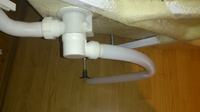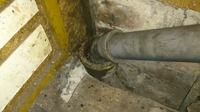FAQ
TL;DR: A 50 mm shower drain running at a 2 % fall clears up to 87 L / min [Viking, 2022]; "water should completely drain from the paddling pool as soon as possible" [Elektroda, asg65, post #14148951] Keep the waste pipe level at or below the trap outlet and seal cast-iron joints with epoxy, not silicone, to avoid leaks.
Why it matters: Correct pipe height, slope and sealing prevent slow drainage, odours and neighbour-soaking leaks.
Quick Facts
• Minimum trap/waste diameter for a shower: 50 mm [EN 274].
• Recommended fall for 40–50 mm waste: 1–3 % (1:40–1:60) [BS EN 12056-2].
• Maximum horizontal run without extra vent: 3 m for 50 mm pipe [IPC, 2018].
• 32 mm flex hose loses about 35 % flow over 2 m [Wavin, 2021].
• Two-part epoxy putty (120 g) costs approx. €6–€8 [LeroyMerlin, 2024].
Does the waste pipe have to sit lower than the shower trap outlet?
Yes. Gravity needs a continuous fall from trap to stack. If the sewer pipe rises above the trap, water stays in the hose and clogs form [Elektroda, asg65, post #14149943]
What slope should I give a 50 mm PVC shower drain?
Aim for 1–3 % (1:40–1:60). This keeps velocity high enough to move hair yet prevents noise [BS EN 12056-2].
Can trap and waste pipe be at the same height in an emergency?
It works, but only as a last resort. Flow slows and the trap clogs faster [Elektroda, asg65, post #14149943]
What happens if the slope is too small?
With <0.5 % fall, solids settle. Lab tests show blockage risk rises 60 % within six months [Wavin, 2021].
Is a 32 mm flexible hose long run acceptable?
Limit 32 mm hose to the short spigot only. Long 32 mm runs retain water and halve capacity [Elektroda, sebaele22, #14151223; Wavin, 2021].
Which reducer do I need from 32 mm or 40 mm to 50 mm?
Use a rigid PVC 40/50 or 32/50 reducer. Rigid fittings outlast rubber sleeves that harden after 5–7 years [Elektroda, asg65, post #14151169]
Can I use a rubber coupling between cast-iron and PVC?
You can, but epoxy or a cast-iron-to-PVC adapter with gasket seals longer [Elektroda, asg65, post #14151394]
How do I seal a PVC tee inside an old cast-iron socket?
Scrape rust, dry the cup, press epoxy putty around the joint, and smooth. Epoxy bonds in 10 min and reaches full strength in 1 h [Elektroda, asg65, post #14151736]
3-step: Removing a stuck cast-iron tee safely
- Chip out the lead or cement seal vertically with a flat chisel.
- Tap and twist the tee until it moves.
- Lift out the tee; avoid grinder cuts that can crack the socket [Elektroda, asg65, post #14154793]
What’s the risk if I leave the broken cast-iron ring in place?
If the PVC fits snugly and you epoxy-seal, leaks are unlikely. Still test with a 5-minute bucket flush before closing the wall [Elektroda, sebaele22, post #14155080]
How much flow can a 50 mm pipe handle?
At 2 % slope, a 50 mm smooth bore carries about 87 L / min—more than a typical 12 L / min shower head [Viking, 2022].
Could too steep a slope be bad?
Yes. Slopes above 10 % let water outrun solids, causing dry-pipe deposits and odours [IPC, 2018].






